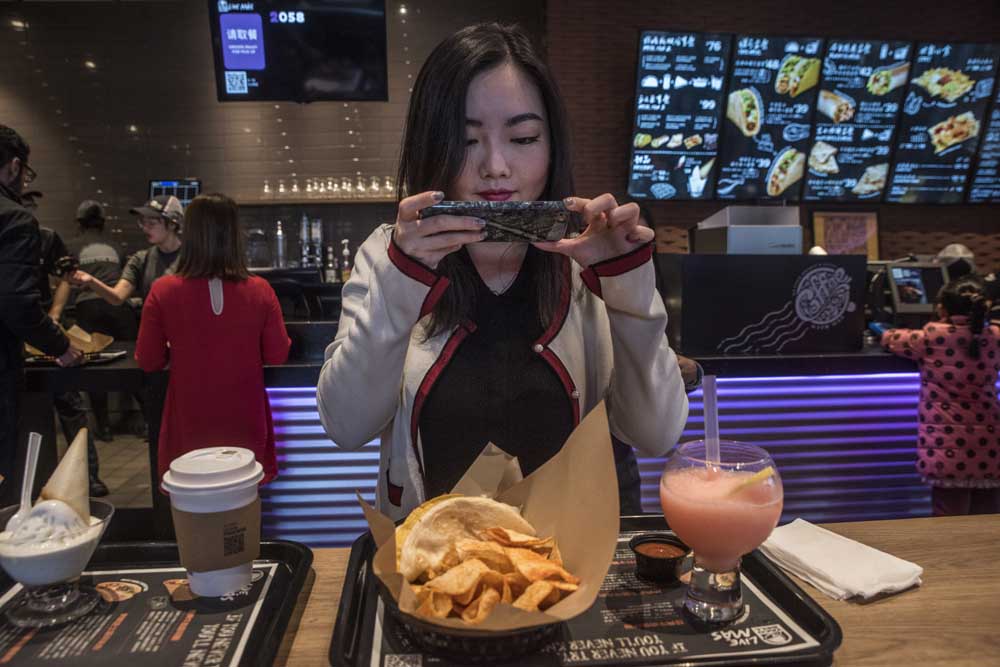China gets first Taco Bell in years
Published 11:38 am Friday, February 17, 2017

- Darcy Zhang, a food blogger in Shanghai, takes a picture of her lunch on Jan. 16 at the first Taco Bell to open in China in years. Unlike its American counterpart, the Taco Bell in Shanghai offers alcoholic beverages such as margaritas. (Gilles Sabre/The New York Times)
SHANGHAI — Until he was appointed manager of a Taco Bell in China, Will Cao had never seen a taco before. When confronted with its hard, U-shaped shell in Los Angeles last June, he wondered: How do you eat it?
“Everything was spilling all over the place,” said Cao, a 31-year-old Shanghai resident. “Then I looked at the other customers to learn that, actually, you are supposed to tilt your neck to eat it.”
Cao’s employer is betting that other Chinese diners will figure it out. Yum China, the company behind KFC there, last month opened the first Taco Bell in China in years, and says it plans to open an unspecified number more. The company is turning to double-layered tacos and overstuffed quesadillas in hopes of regaining ground in a market where its fried chicken has shown the limits of its appeal.
It won’t be easy. First, there is the matter of what’s on the menu: Mexican food. Tacos and burritos are virtually unknown in China, where many diners prize aspirational noshes from Europe, Japan and the United States, and look skeptically at what they see as poorer fare from other developing countries.
Then there is Taco Bell’s very American take on Mexican meals. Even among fans, many of its more artery-hardening menu items are best considered late-night guilty pleasures. “It’s like a dirty thing that I love Taco Bell so much,” actress Anna Kendrick once said on Conan O’Brien’s talk show, adding, “it has to be under cover of darkness in my car.”
For its new store in Shanghai, Taco Bell is leaving behind some of those greasy American favorites, such as taco shells made out of Doritos or fried chicken cutlets. Instead, as it once successfully did with KFC, Yum China is tailoring the menu to local tastes. It is offering basic, understandable Tex-Mex fare such as a crunchy taco supreme and a chicken quesadilla. Other dishes made for the Chinese market include a shrimp and avocado burrito and a spicy fried chicken dish, a meal that has broader appeal with the Chinese.
And in a feature rare in the United States — perhaps for good reason — the China store offers Japanese beer and alcoholic slushes.
Yum China is aware of the magnitude of the challenge. Micky Pant, its chief executive, says eating a taco is “a whole new way of learning.”
The company is learning its own lessons. In the 1990s, Chinese consumers flocked to KFC and other Western fast-food chains, drawn by their clean bathrooms and air-conditioning — a novelty in China at that time.
But restaurants like McDonald’s and KFC have since struggled against increasing competition from quick-service Chinese restaurant chains and a shift toward healthier eating.
While China is still a lucrative market for companies including Apple, Nike and Starbucks, other U.S. firms are finding the going tougher than it used to be. The once seemingly insatiable appetite for all things foreign has stalled in a marketplace where domestic brands are catching up and consumers are richer, with more choices than ever.
U.S. fast-food chains are distancing themselves from their China operations. Yum Brands divested Yum China last year, while McDonald’s is selling a controlling stake in its business to a locally led investor group.
That led to Yum China’s gamble on Taco Bell. Instead of Taco Bell’s U.S. approach — quick, cheap, often unabashedly junky — the Shanghai restaurant seems intent on easing Chinese diners into ordering. The menu in China features enlarged images of foods on a lighted board and a transparent kitchen, where skeptical customers can watch their food being assembled.
Yum dropped fajitas because focus groups said Chinese people did not like the “peppery type of spiciness that Westerners like,” said Jimmy Chen, senior director of Yum China’s brand development division. They also asked for alcohol to be offered.
Yum has tried Taco Bell in China before. In 2003 it opened full-service restaurants called “Taco Bell Grande” in Shanghai, then in the southern city of Shenzhen, offering higher-end fare like steaks and fajitas. But it pulled out five years later.
Still, Yum once seemed to have cracked the China code. Since opening its first KFC near Tiananmen Square in 1987, Yum has grown into the biggest Western fast-food chain in the country, with more than 7,300 stores in over 1,100 cities, three times that of its rival McDonald’s.
Yum China formally opened the Taco Bell on Jan. 9 in Shanghai’s prime Lujiazui area, a popular tourist spot.
On a recent Tuesday, the store was packed at lunch, with a 15-minute wait to get a table. Diners sat on chairs below surfboards suspended from ceilings. Workers in polo shirts served margaritas and draft beer.
“If you didn’t tell me, I wouldn’t even know this was Mexican food,” said Zang Jing, 30, a bank clerk, adding that she thought the food was “not bad.”








